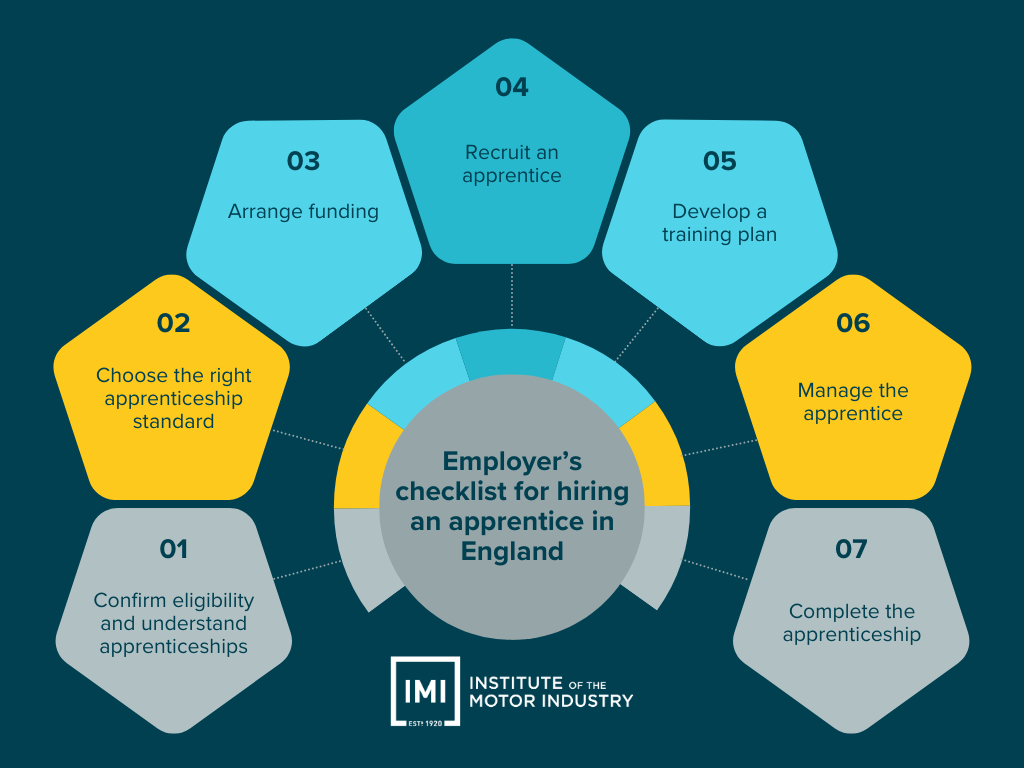Everything you need to know: Hiring an apprentice in England

As the professional body for the automotive sector, the IMI represents over 110,000 members, championing the industry and addressing the growing skills gap.
One way you as an employer can support bringing new talent into the sector is by hiring an apprentice. Apprenticeships are a fantastic way to invest in your business' future, bring fresh talent into your team, and contribute to workforce development.
To make the process straightforward, we’ve created this simple checklist. It provides all the essential steps, guidance, and links you’ll need to confidently navigate hiring an apprentice in England. Whether you're new to apprenticeships or looking to refine your approach, this resource ensures you have everything at your fingertips.

Step 1: Confirm Eligibility and Understand Apprenticeships
Eligibility:
- Your business must operate in England
- You must be able to provide the apprentice with a role that is relevant to the apprenticeship framework or standard
Understand what an apprenticeship involves:
- Apprenticeships combine on-the-job training with study, leading to a qualification
- Apprentices must work at least 30 hours a week
- Check your return on investment with the IMI's ROI calculator
Step 2: Choose an Apprenticeship Standard
Identify the right apprenticeship:
- Standards outline the skills, knowledge, and behaviours apprentices need to learn. Use the Apprenticeship Standards Directory to find a programme relevant to your industry and the apprentice’s role.
Select a training provider:
- Training providers deliver the educational component and help structure the apprenticeship. Use the government’s Find Apprenticeship Training tool to locate registered training providers.
Step 3: Arrange Funding
Understand funding rules:
- If your business has a payroll over £3 million annually, you pay into the Apprenticeship Levy, which funds apprenticeships. OR
- If your business does not pay the Levy, you can still receive 95% government funding for apprenticeship training costs.
Set-up an apprenticeship service account:
- Register on the Apprenticeship Service Portal to manage funding, recruit apprentices, and assign training providers.
Apply for incentive payments (if applicable):
- Employers can claim government incentives for hiring apprentices under specific conditions.
Step 4: Recruit an Apprentice
Advertise the role:
- Work with your chosen training provider to list the apprenticeship vacancy on the Find an Apprenticeship service
- You can also advertise independently through your company’s channels
- Use IMI Auto Jobs to advertise free of charge, email us to find out more
Screen candidates:
- Ensure applicants meet the minimum eligibility criteria, including the right to work in the UK and meet apprenticeship age requirements (16+).
Step 5: Develop a Training Plan
Agree on a commitment statement:
- With your training provider, outline the training schedule, including on-the-job and off-the-job training
Set expectations:
- Define clear goals for the apprentice
- Allocate time for the apprentice to complete off-the-job training (minimum 20% of their working hours). This can either be a day release (one day in training and 4 at the workplace) or block release (1 week at training and then weeks/months at the workplace)
Step 6: Manage the Apprenticeship
Support and supervise:
- Assign a mentor or supervisor to guide the apprentice during their training.
- Regularly review progress with the apprentice and the training provider.
- Sign your apprentice up for IMI Student Membership
Meet compliance:
- Keep records of the apprentice’s training and working hours.
- Ensure they are paid at least the Apprenticeship Minimum Wage (or higher).
Step 7: Complete the Apprenticeship
End-Point Assessment (EPA):
- Ensure the apprentice completes the EPA, which assesses their skills and knowledge.
Certification:
- Upon passing the EPA, the apprentice will receive a nationally recognised qualification
Employment:
- After completing the apprenticeship, you can offer the apprentice a permanent role in your organisation
With this checklist, you now have a clear and concise roadmap to successfully hiring and managing an apprentice in England. By following these steps, you can navigate the process with confidence, ensure compliance, and maximise the benefits for your business and the apprentice. Use the provided resources to support each stage, and don’t hesitate to reach out to training providers or industry experts for additional guidance. Investing in apprenticeships is an investment in the growth and success of your team—start your journey today!

